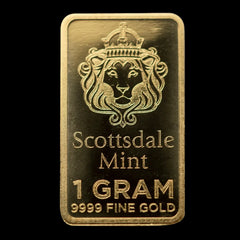It Started In 2009
At the beginning of my journey with gold & silver in early 2009, the only goal I had in mind was to protect as much of my hard-earned money from inflation as I could. In those early days of buying gold & silver, I was motivated by fear. I felt like I couldn’t get enough because I was convinced of the imminent collapse of the US Dollar and the entire financial system. At that time, if someone had asked me how much gold and silver I should own – my answer was simple – as much as I could get my hands on!

More on the falling purchasing power of the US Dollar from the Visual Capitalist here:
https://www.visualcapitalist.com/purchasing-power-of-the-u-s-dollar-over-time/
Why I Started My Precious Metals Journey With Silver
Because the collapse of the global financial was such a major fear of mine, much of my early stacking was focused on silver. I was specifically interested in silver because I believed I would be using it for small financial transactions (purchasing food) in the fallout of a fiat currency collapse.
16 years have passed since then, and the US Dollar is still around. In fact, judging its recovery by the US Dollar Index (DXY), which reflects the value of the USD in global trading markets, it has fully recovered its status as the king of fiat currencies and is currently above its 50-year average (a trend I expect to reverse in the coming years). The DXY is quoted in USD and serves as a key benchmark for currency trading.

Check out the live DXY chart from tradingeconomics.com here:
https://tradingeconomics.com/dxy:cur
What I Learned From My Early Days In Precious Metals
Today I realize that I was naïve to buy into the doomsday narratives being spun by people online from 2008 to 2012. Of course, that doesn’t mean I think the US Dollar is perfectly safe – it will have its day of reckoning! But the entire financial crisis taught me some very important lessons that took me time to understand and apply to my personal financial strategy. They were:
-
People trust fiat currency much more than they should. For that reason, its demise is going to be slower than many people would have you believe.
-
Many people purchase gold & silver as a reaction to their concerns and fear. Buying precious metals should really be seen as an act of confidence in its ability to protect your savings like no other asset.
-
Most importantly, people plan too much for unlikely emergency scenarios and too little for probable emergency scenarios. A proper analysis of your personal risks and needs is essential, such as:
-
Loss of job
-
Medical emergency
-
Home repairs / Car trouble
-
Death in the family
-
Reduction in benefits / fixed income
-

More inspirational quotes on planning here:
https://www.brainyquote.com/quotes/alan_lakein_154655
How I First Calculated How Much Gold & Silver I Need To Have
Understanding these 3 things, I decided to figure out a universal goal. One that I could start stacking towards, but also share with friends and eventually people on YouTube. A target that would prepare myself and others for the likely emergencies I mentioned above – but also prepare us for the less likely scenario of a total financial collapse. Ultimately, I wanted to answer the question – how much gold and silver should I own?
As I didn't want to reinvent the wheel, I decided that the rule of thumb most financial advisors use (which is to have 3 to 6 months of expenses saved up) was an appropriate starting target to build a gold & silver stack with.

More on establishing an emergency savings fund here:
https://www.chase.com/personal/banking/education/budgeting-saving/how-much-should-i-have-in-emergency-fund
Of course, 3 to 6 months of expenses varies depending on where you live (and I will cover that more later in the article), but I decided that my universal target should be benchmarked to a wealthy country like the United States. By doing that, most people would be covered by the target no matter where they live. Since this was meant to be a minimum stacking target – meaning a first goal for people to strive for - I followed this process:
-
Took the average monthly expenses for an American (according to the bureau of labor statistics).
-
I eliminated expenses I thought were unnecessary in an emergency (like entertainment expenses).
-
I multiplied the monthly figure by 3 to come to a 3-month survival fund.

More on monthly expenses here:
https://www.chase.com/personal/banking/education/budgeting-saving/average-american-monthly-expenses-and-bills#:~:text=Monthly%20expenses%20list,personal%20care%20products%20and%20books.
The Benefits of Diversification: Why Gold & Silver Aren’t the Only Answer
When it comes to building a strong financial foundation, owning gold and silver is a smart move—but it’s only one piece of the puzzle. Diversification is the key to long-term financial health, and that means spreading your investments across a range of assets, not just precious metals. While gold coins, silver bullion, and even platinum bars have their place in a well-rounded portfolio, relying solely on these metals can leave you exposed to unnecessary risk.
Precious metals like gold and silver have long been valued for their ability to hedge against inflation and provide stability during times of market uncertainty. Gold jewelry, silver coins, and silver bars are tangible assets that can hold their value when currencies fluctuate or economies face turbulence. The spot silver price, for example, often rises when investors seek safety, and the silver trade can offer opportunities for profit as demand shifts in the industry. However, the prices of these metals can also be volatile, influenced by factors such as industrial demand, new discoveries, and changes in global supply.
That’s why it’s important to think beyond just gold and silver. A truly balanced investment strategy includes a mix of assets—stocks for growth, bonds for stability, real estate for income and diversification, and even alternative investments like commodities. Within the world of metals, adding platinum and palladium to your holdings can further spread your risk, since their prices are often driven by different market forces than gold and silver. For example, while gold may rise during geopolitical uncertainty, platinum prices might be more closely tied to the automotive industry and industrial demand.
Investors should also pay attention to how much of their portfolio is allocated to each asset. Understanding the value of a troy ounce, tracking spot silver and gold prices, and keeping an eye on futures contracts can help you make informed decisions about when to buy or sell. It’s also wise to consider the form your precious metals take—whether you prefer gold coins, silver bars, or even ETFs that track the price of metals—so you can maintain liquidity and flexibility in your investments.
The real power of diversification comes from balancing risk and reward. By holding a range of assets, you’re less likely to be caught off guard by a sudden drop in one market or a spike in another. For example, if silver prices dip due to a surge in supply, gains in your stock or real estate investments can help offset those losses. Over the long term, this approach can help smooth out the ups and downs of the market, giving you a more stable path to financial growth.
In summary, while gold and silver are essential tools for protecting your wealth, they work best as part of a diversified investment strategy. By including a variety of assets—across metals, industries, and geographies—you can hedge against risk, capture new opportunities, and build a portfolio that stands the test of time. Whether you’re stacking gold coins, investing in silver content for the future, or exploring the world of platinum and palladium, remember: diversification is your best defense in an unpredictable world.

Link to the original Bald Guy Money Video from 2021 with minimum gold & silver ownership targets:
https://www.youtube.com/watch?v=Oqe2ej13zLw
How Much Gold & Silver My Approach Told Me I Needed To Have
In 2021 when I first did the exercise publicly, the average monthly expenses I identified totaled $4,389 ($13,167 for 3 months). To cover that, with some additional buffer, I determined the first level stacking target at 5 troy ounces of gold and 200 troy ounces of silver (a 40 to 1 ratio, meaning the value of 40 ounces of silver is equal to 1 ounce of gold). This target, when converted to US Dollar at spot price, gave a 3.3-month coverage for an American’s average monthly expenses as per the Bureau of Labor Statistics.
Precious metals like gold and silver are typically measured by weight, most commonly in troy ounces. However, they can also be measured in grams, with 1 troy ounce equal to approximately 31.1 grams. This allows for more precise pricing and measurement in the market.
For those wondering why I chose to allocate 64% of my US Dollars to Gold and only 36% to silver in 2021, the answer is simple – volatility! Although I recognize an opportunity for silver to outperform gold over the next 3 to 5 years, gold has proven itself to be the more stable over long periods of time. Because the purpose of this exercise is to put together an emergency savings stack – I think it’s best to put more towards the less volatile of the two metals when allocating money between them.
Has That Amount Of Gold & Silver Stayed Relevant Over Time?
Since my first attempt in 2021 to answer the question - “how much gold and silver should I own?” – the face of the global economy and the precious metals markets has changed. In 2022, the US CPI went as high as 9.1% year over year in June. The annual rate for that year came in at a whopping 8% - the highest level since 1981’s bout with stagflation! At present, the value and amount of gold and silver available are influenced by these changing markets, and even slight shifts in economic conditions can impact their coverage and purchasing power. It was around that time and in the following year that people started to ask me – is 5 ounces of gold and 200 ounces of silver still enough? When reviewing price charts or data on this page, remember that you can often lock in prices when purchasing gold and silver, especially during periods of market volatility.

Link to Bureau of Labor Statistic Inflation Data:
https://www.bls.gov/charts/consumer-price-index/consumer-price-index-by-category-line-chart.htm
To determine that, I started with an apples-to-apples comparison of the expenses I counted in 2021 and compared them to where they were in 2024. In line with official inflation figures (which we can question in another article), the average monthly expenses for an American rose 20% between 2021 and 2024. That took the total amount needed to be covered for an emergency from $13,167 up to $15,861 (from 4,389 per month to $5,287 per month).

More data from the US Bureau of Labor Statistics here:
https://www.bls.gov/cpi/
As I am now writing this in September 2024, if we compare the prices of gold & silver to where we were in 2021 when I did the original calculation – you can see that gold is up 42% and silver is up 17%. When applied to our “how much gold & silver should I own” target of 5 ounces of gold and 200 ounces of silver – the total value of that went from $14,300 to $19,039 (an increase of 33% vs. a 20% increase in total monthly expenses). Since our gold & silver outperformed official inflation figures – it means that minimum target amount now covers 3.6 months of expenses vs. only 3.3 months of expenses in 2021.
When we account for increases and drops in the prices of precious metals, I think it's safe to say that the original target of 5 ounces of gold and 200 ounces of silver is as relevant today as it was back in 2021. For that reason, I stand by it as the ultimate answer to the question – how much gold & silver should I own?

More Gold & Silver Price data at the links below:
https://www.tradingview.com/symbols/XAUUSD/
https://www.tradingview.com/symbols/SILVER/
How Much Gold & Silver Do I Need To Protect My Family?
For customers wondering if this amount is sufficient for their family or if they need less as a single person living in a low-cost state, I’ve got you covered! Below is a screenshot from a tool available on my website, designed to help customers calculate their gold and silver needs online. The tool allows you to select the different forms of gold and silver you wish to hold—such as coins, bars, rounds, ETFs, or certificates—so you can tailor your holdings to your preferences. It also adjusts calculations based on the state or country where you are located, ensuring results are relevant to your specific situation. You can customize for whether you’re single or have a family, your preferred gold & silver split (if my 40 to 1 ratio isn’t to your liking), and all results are based on live pricing.

Link to Bald Guy’s emergency fund calculator tool:
https://www.patreon.com/posts/gold-silver-fund-87616653?utm_medium=clipboard_copy&utm_source=copyLink&utm_campaign=postshare_creator&utm_content=join_link
Any Tips For People Outside Of The USA?
For my international viewers & readers, the same tool is available for you based on your national averages if you are located in the following countries:
-
Canada
-
Germany
-
Australia
-
United Kingdom
-
India
-
Japan
This tool is provided by our company to ensure users located around the world have access to accurate information.

Link to Bald Guy’s emergency fund calculator tool:
https://www.patreon.com/posts/gold-silver-fund-87616653?utm_medium=clipboard_copy&utm_source=copyLink&utm_campaign=postshare_creator&utm_content=join_link
Final Thoughts
Today, some of you may still be in fear mode like I was when I started in late 2008 / early 2009. You may be anxiously anticipating the end of the US Dollar and collapse of the financial system. To you I say - it’s important to remember that gold & silver are not lottery tickets. Their superpower is not to make you unbelievably wealthy overnight in the aftermath of something many people have died waiting for.
Gold, as a metal with unique properties, is highly valued for its ability to reflect light and heat, making it useful in both industry and technology. Gold is also a limited resource, which adds to its appeal as an investment. Its liquid nature means it can typically be converted to cash quickly, making it a preferred asset for many parties involved in financial transactions. The discovery of gold's value throughout history has led to its use in various forms, such as gold bars, gold coin, and jewelry, with its weight often measured in grams or ounces. Gold is also used in electronics, including your phone, due to its excellent conductivity. In investment, gold and silver are often referred to as safe-haven assets, and the terminology used when referring to these metals—such as spot price or bullion—is important to understand. Silver investment options typically include coins, bars, and rounds, with rounds and silver rounds being popular choices. The scale of gold and silver investment can range from small personal holdings to large institutional reserves. The example from this article perfectly demonstrates why gold & silver are so important to own and why setting a target for ownership is just as important. Be prepared with silver & gold – just be realistic about what it is you are preparing for.






